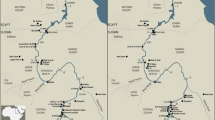Abstract
One aspect of an ethno-archaeological study of the pottery system of the Luo people of Kenya is examined. It was discovered that ceramic ‘micro-styles’, distinctive combinations of decorative, formal and technological features characteristic of the different potter communities in a 3000 km2 region of western Kenya, are the product of local traditions of manufacture perpetuated by women potters recruited from outside the communities as a result of a patrilocal post-marital residence system. An analysis of the interplay of a mother-in-law/daughter-in-law learning pattern, strong pressures for post-marital resocialization, and processes of potter interaction in the generation of ceramic styles is undertaken and some implications for archaeological attempts to use ceramic patterning to uncover prehistoric social organization are discussed.
Résumé
L'article examine un aspect d'une étude ethno-archéologique du système céramique du peuple Luo de Kenya. On a trouvé que des ‘micro-styles’ céramiques, des combinaisons distinctives de traits décoratifs, formels et technologiques qui caractérisent les différentes communautés de potières dans une région de 3000 kilomètres carrés au Kenya occidental, sont le produit de traditions locales de fabrication. Ces traditions sont perpétuées par des potières recrutées hors des communautés à cause d'un système de résidence patrilocale après le mariage. L'auteur entreprend une analyse de l'interaction entre trois éléments dans la formation des styles céramiques: une tendance d'enseignement des méthodes de fabrication à belle-fille par belle-mère, des pressions intensives vers une ‘resocialisation’ après le mariage, et des processus d'interaction entre potières. Elle discute quelques implications pour les archéologues qui essaient d'utiliser la structuration de la céramique afin de découvrir l'organisation sociale préhistorique.
Similar content being viewed by others
References
Allen, W. L. and Richardson, J. B. 1971. The reconstruction of kinship from archaeological data: the concepts, the methods, and the feasibility.American Antiquity 36:41–53.
Binford, L. R. 1965. Archaeological systematics and the study of culture process.American Antiquity 31:203–10.
Bohannan, P. and Dalton, G. 1962. Introduction. InMarkets in Africa (eds. P. Bohannan and G. Dalton): pp. 1–26. Evanston: Northwestern University Press.
Clarke, D. L. 1968.Analytical Archaeology. London: Methuen.
Deetz, J. 1965.The Dynamics of Stylistic Change in Arikara Ceramics. Chicago: University of Illinois Press.
Dietler, M. 1986. Women, wealth, and the origin of markets in Alego: an ethnohistorical study in western Kenya. Unpublished paper presented at the Conference in Honour of J. Desmond Clark, Berkeley, April 1986.
Evans-Pritchard, E. E. 1949. Luo tribes and clans.Rhodes-Livingstone Journal 7:24–40.
Herbich, I. 1981.Luo Pottery: Socio-Cultural Context and Archaeological Implications (an interim report). Nairobi: Institute of African Studies, University of Nairobi, Paper 155.
Herbich, I. 1986. Process and pattern in the distribution of Luo ceramic styles. Paper presented at the 85th Annual Meeting of the American Anthropological Association, Philadelphia, December 1986.
Herbich, I. in prep.Luo Potters and Pottery: an ethno-archaeological study of a regional ceramic system in its social context. Ph.D. thesis, University of California, Berkeley.
Herbich, I. and Dietler, M. in press. Luo pots and potters. InTraditional Kenyan Pottery (eds. J. Barbour and S. Wandibba). Nairobi: Oxford University Press.
Hill, J. N. 1970.Broken K Pueblo: prehistoric social organization in the American Southwest. Anthropological Papers of the University of Arizona, 18. Tucson: University of Arizona Press.
Kramer, C. 1985. Ceramic ethnoarchaeology.Annual Review of Anthropology 14:77–102.
Longacre, W. 1970.Archaeology as Anthropology: a Case Study. Anthropological Papers of the University of Arizona, 17. Tucson: University of Arizona Press.
Ogot, B. A. 1963. British administration in the Central Nyanza District of Kenya, 1900–60.Journal of African History 4:249–73.
Ominde, S. H. 1952.The Luo Girl: from infancy to marriage. London: Macmillan.
Ominde, S. H. 1984. Recent demographic trends in Kenya and their implications for economic and social development. InPopulation and Development in Kenya (ed. S. H. Ominde). Nairobi: Heinemann.
Southall, A. W. 1952.Lineage Formation among the Luo. International African Institute Memorandum 26. London: Oxford University Press.
Whallon, R. 1968. Investigations of late prehistoric social organization in New York State. InNew Perspectives in Archaeology (eds. S. R. Binford and L. R. Binford): pp. 223–44. Chicago: Aldine.
Whisson, M. G. 1964.Change and Challenge. Nairobi: Christian Council of Kenya.
Rights and permissions
About this article
Cite this article
Herbich, I. Learning patterns, potter interaction and ceramic style among the Luo of Kenya. Afr Archaeol Rev 5, 193–204 (1987). https://doi.org/10.1007/BF01117093
Issue Date:
DOI: https://doi.org/10.1007/BF01117093




